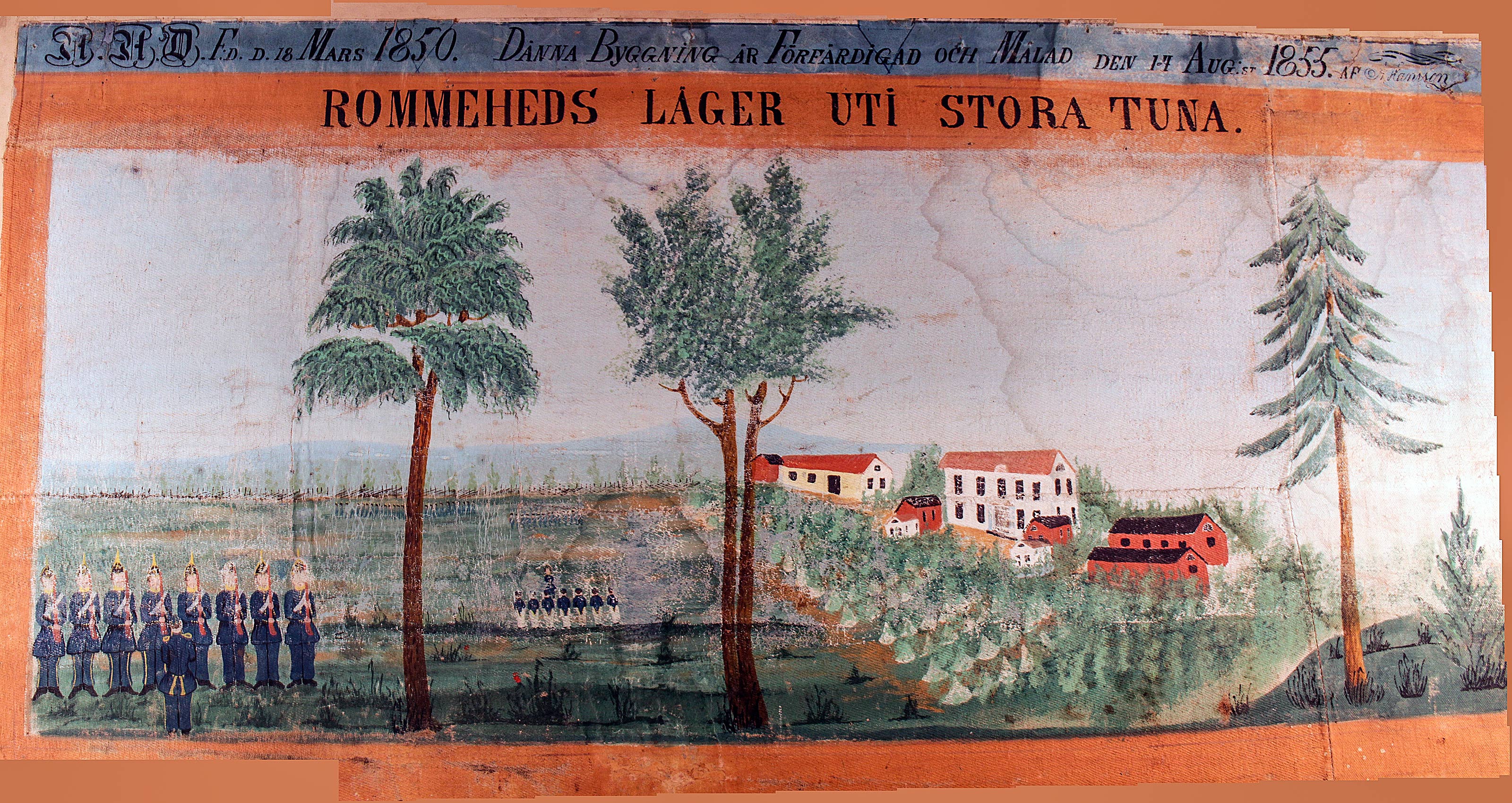
A quick Google translation, slightly edited:
In our museum at Rommehed there is a copy of the below Dalarna painting.
The original belongs to the American Swedish Institute in Minneapolis, USA.
A Swedish related lady named Inga has kindly provided a high-quality image of the original.
This Dalarna painting was made by Erkers Anders Hansson from Rättvik in 1855
At the top of the painting we can read:
A.A.D.F: D 18 MARCH 1850 THIS BUILDING IS CONSTRUCTED AND PAINTED ON 17 AUG: ST 1855. BY A.Hansson
THE ROMMEHED CAMP IS LOCATED IN STORA TUNA
The painting is included in the book Dalmåleri ( Dalarna painting, The Dalarna painters - their life and work)
2007, ISBN 978-91-87466-85-4
Roland Andersson, Rune Bondjers, Johan Knutsson, Margareta Andersson
An impressive 3 kilo book with an impressive BIG collection of Dalarna painters biographies in addition to a number of very informative chapters on the Dalarna painting from various aspects.
The picture material can only be described as wonderful.
We quote:
Erkers Anders HansSon | Gulleråsen - Gruvriset
Klockar Anders HansSon | Västra Boda
1834-1869
(Webmasters note: The upbringing in the mother's home gave him the farm name Erkers, as a married man he lived on his wife's homestead hence the change to the farm name Klockar.
As a singer in the church, he was also called Singer Anders.)
PARENTS: Gisslar Hans Ersson (1794-1839) from Änderåsen nr 6
Erkers Kerstin Hansdotter (1797-1878) from Gulleråsen nr 10
They married in 1823 and settled on Gulleråsen no. 10
SIBLINGS: Hans 1823, Erik 1825, Kerstin 1828, Lisbet 1830
MARRIED: 1859 with Brittas Lisbet Jonsdotter (1839—) from Gruvriset nr 7
Resident at Gruvriset nr 7, then Västra Boda sub 6 (Klockar homestead)
CHILDREN: Hans 1860, Anders 1861, Kerstin 1864, Jonas 1868
Anders grows up in his mother's home in Gulleråsen together with four older siblings. The father has the character "kind". In the 1830s the household is termed 'poor', the father dies in 1839, at the age of 45. Brother Erik marries in 1854 and stays with his family in the childhood home.
In 1859 Erkers Anders married, and the couple moved to his wife's home in Gruvriset. Brittas Lisbets mother and three sisters and brother Jon with family also live on the farm.
In 1868 the family moved to Västra Boda sub 6, the Klockar (sexton) homestead. Anders' wife was the daughter of the former sexton Brittas Jon Olsson (dead 1851).
1869 Klockar Anders dies only 35 years old and his wife gets alone with four children in small circumstances.
Erkers Anders learns to read early from an old soldier. School priest Johan Bärsäll and the parson Per Ulrik Bothius help him so at the age of 16 (1850) he can serve as a school teacher in various villages around Boda.
Anders is supposed to have been a true singer and becomes 1857 song leader in Boda church. "Sjungar (singer) Anders" as he is now called, has a beautiful handwriting and, besides his service as village teacher and singer, he also undertakes to act as a scribe. In Boda church archives, there is, among other things, a proposal for sobriety rules for the congregation, which Erkers Anders put together. However, in 1867 he was suspended from the mission as a singer, when he repeatedly arrived drunk to the church.
Ollas Anders (researcher) in his report in 1921 shows that he knows Erkers Anders as a painter. Erikhans Hans (researcher) can in his notes from 1944 supply some information he received from his own father who was "singer" in the church both before and after Erkers Anders sejour. He also knows that Erkers Anders learned early on the paintwork from neighbor boys Nygårds Anders and Olof. Later, Erkers Anders often came to work with Torrångs Olof Samuelsson.
Erkers Anders is a painter at the time of break when the old biblical motifs with blossoms and rose painting begin to be passe. Erkers Anders preferably paints profane motifs, extraordinary buildings, cityscapes and landscapes. He has a sense of perspective and proportions and creates a livelier representation of animals and people than the Dalarna painters in the common.